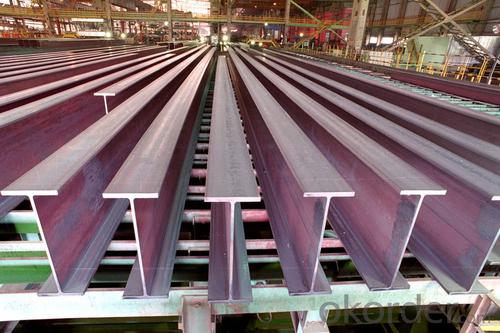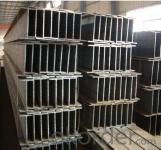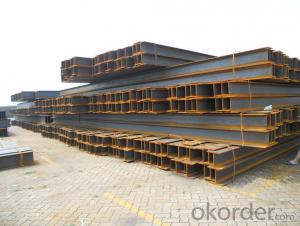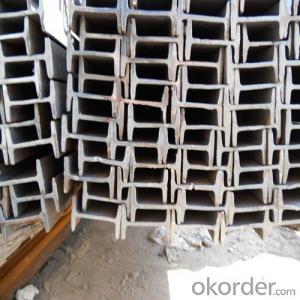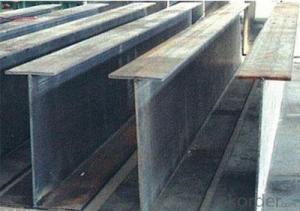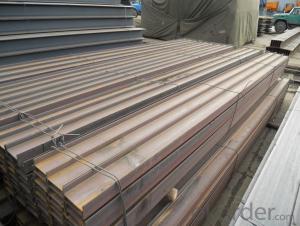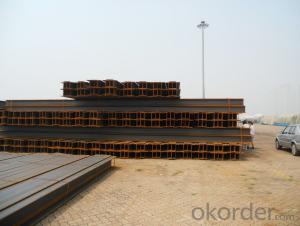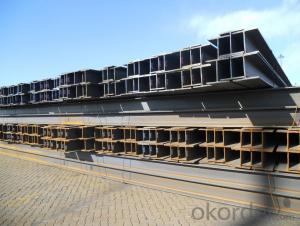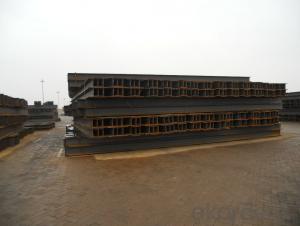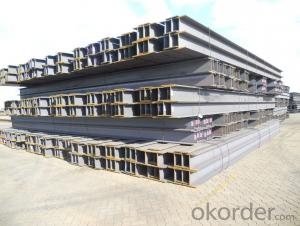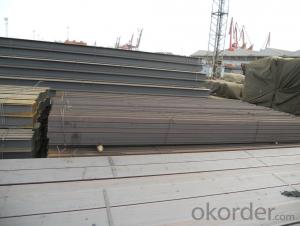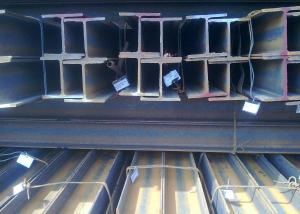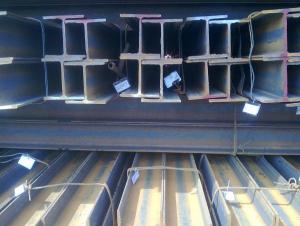JIS SS400 H Beam With High Quality
- Loading Port:
- China Main Port
- Payment Terms:
- TT or LC
- Min Order Qty:
- -
- Supply Capability:
- -
OKorder Service Pledge
OKorder Financial Service
You Might Also Like
Product Description:
OKorder is offering JIS SS400 H beam with high quality at great prices with worldwide shipping. Our supplier is a world-class manufacturer of steel, with our products utilized the world over. OKorder annually supplies products to European, North American and Asian markets. We provide quotations within 24 hours of receiving an inquiry and guarantee competitive prices.
Product Applications:
JIS SS400 H beam with high quality are ideal for structural applications and are widely used in the construction of buildings and bridges, and the manufacturing, petrochemical, and transportation industries.
Product Advantages:
OKorder's JIS SS400 H beam with high quality are durable, strong, and resist corrosion.
Main Product Features:
· Premium quality
· Prompt delivery & seaworthy packing (30 days after receiving deposit)
· Corrosion resistance
· Can be recycled and reused
· Mill test certification
· Professional Service
· Competitive pricing
Product Specifications:
1. Standard: JIS 3192
2. Grade: SS400 or Equivalent
3. Length: 10m, 12m as following table
4. Invoicing on theoretical weight or actual weight as customer request
5.Payment: TT or L/C
Size and Mass of H beam:
Size (mm) | Mass (Kg/m) | Size (mm) | Mass (Kg) |
100*100*6.0 | 16.9 | 148*100*6.0 | 20.7 |
125*125*6.5 | 23.6 | 150*150*7.0 | 31.1 |
150*75*5.0 | 14.0 |
1. Packing: it is nude packed in bundles by steel wire rod
2. Bundle weight: not more than 3.5MT for bulk vessel; less than 3 MT for container load
3. Marks:
Color marking: There will be color marking on both end of the bundle for the cargo delivered by bulk vessel. That makes it easily to distinguish at the destination port.
Tag mark: there will be tag mark tied up on the bundles. The information usually including supplier logo and name, product name, made in China, shipping marks and other information request by the customer.
If loading by container the marking is not needed, but we will prepare it as customer request.
4. Transportation: the goods are delivered by truck from mill to loading port, the maximum quantity can be loaded is around 40MTs by each truck. If the order quantity cannot reach the full truck loaded, the transportation cost per ton will be little higher than full load.
5. Delivered by container or bulk vessel
FAQ:
Q1: Why buy Materials & Equipment from OKorder.com?
A1: All products offered byOKorder.com are carefully selected from China's most reliable manufacturing enterprises. Through its ISO certifications, OKorder.com adheres to the highest standards and a commitment to supply chain safety and customer satisfaction.
Q2: Can fit in the containers of 20fts the steel beams of 6M?
A2: No proble, we can put them into the containers in the form sideling.
Q3: How soon can we receive the product after purchase?
A3: Within three days of placing an order, we will begin production. The specific shipping date is dependent upon international and government factors, but is typically 7 to 10 workdays.
Images:
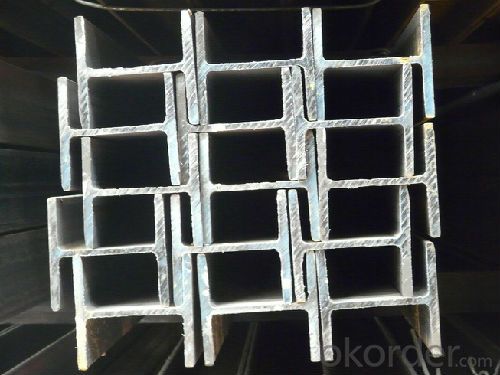
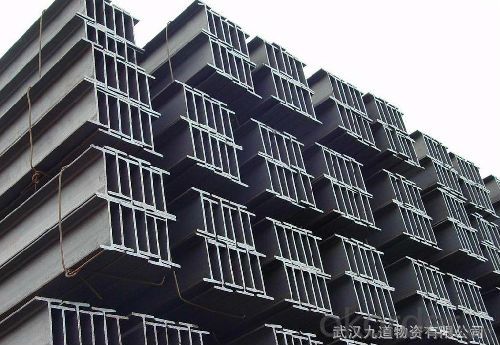
- Q: How do you calculate the plastic section modulus of steel H-beams?
- To determine the plastic section modulus of steel H-beams, it is necessary to go through a series of steps. The plastic section modulus serves as a measure of the beam's resistance to bending and is crucial in establishing its load-carrying capability. Firstly, the geometry of the H-beam must be determined. The plastic section modulus relies on various dimensions, including the width, height, flange thickness, and web thickness of the H-beam. These measurements are typically provided by the manufacturer or can be directly measured. Next, the area of the H-beam must be calculated. This involves subtracting the area of the flanges from the area of the web. The formula for the H-beam's area is as follows: Area = (2 * flange thickness * flange width) + (web thickness * web height). The centroid of the H-beam needs to be calculated as well. The centroid represents the point at which the entire area of the H-beam can be considered to act. The formula for determining the centroid is: Centroid = (A1 * y1 + A2 * y2) / (A1 + A2). In this formula, A1 and A2 refer to the areas of the flanges and web, respectively, while y1 and y2 represent the distances from the centroid of each area to the neutral axis. The moment of inertia, which gauges the H-beam's resistance to bending, must also be calculated. The parallel axis theorem can be used to determine the moment of inertia. The formula for the moment of inertia is as follows: I = (A1 * y1^2) + (A2 * y2^2) + (A1 * (y1 - Centroid)^2) + (A2 * (y2 - Centroid)^2). In this formula, A1, A2, y1, y2, and Centroid are defined as in step 3. Finally, the plastic section modulus can be calculated by dividing the moment of inertia by the distance from the neutral axis to the extreme fiber, which is typically the point of maximum stress. The formula for the plastic section modulus is: Z = I / c. In this formula, Z represents the plastic section modulus, I denotes the moment of inertia, and c signifies the distance from the neutral axis to the extreme fiber. By following these steps and utilizing the appropriate formulas, one can accurately compute the plastic section modulus of steel H-beams. This value is crucial in ascertaining the beam's load-carrying capacity and its ability to withstand bending forces.
- Q: Can steel H-beams be used for bridges?
- Certainly! Bridges can indeed make use of steel H-beams. Due to their durability, versatility, and high strength-to-weight ratio, steel H-beams are frequently employed in the construction of bridges. These beams possess exceptional load-bearing capacity and can withstand heavy loads, making them suitable for a wide range of bridge designs and spans. Furthermore, steel H-beams exhibit resistance to corrosion, a vital characteristic for bridges that are exposed to environmental elements. The availability of these beams in various sizes and shapes enables engineers to design bridges that meet specific requirements. All in all, steel H-beams are a favored option when it comes to constructing bridges, thanks to their unwavering structural integrity and reliability.
- Q: Can steel H-beams be used in the construction of agricultural buildings?
- Agricultural buildings can utilize steel H-beams for their construction. These beams are widely favored in the construction industry due to their strength, durability, and versatility. They possess exceptional load-bearing capacity, which enables them to support the weight of the building and any additional equipment or machinery stored within. Moreover, steel H-beams are resistant to rot, pests, and fire, making them highly suitable for agricultural buildings that may face harsh environmental conditions. What's more, these beams can be easily fabricated and customized to precisely fit the specific requirements of the agricultural structure, ensuring optimal structural integrity. Overall, steel H-beams provide numerous benefits for agricultural construction projects, which is why they are highly preferred by architects, engineers, and farmers.
- Q: How do steel H-beams perform in high-rise buildings?
- Steel H-beams are commonly used in the construction of high-rise buildings due to their excellent performance under vertical loads and their ability to withstand high levels of tensile and compressive forces. These beams provide structural stability and support by distributing the building's weight evenly across their span, allowing for the construction of taller and more efficient structures. One of the key advantages of steel H-beams in high-rise buildings is their high strength-to-weight ratio. This means that they can support heavy loads while being relatively lightweight, making them ideal for constructing tall buildings where weight reduction is crucial. Additionally, steel H-beams have a high level of flexibility, allowing them to bend and deform under extreme loads without compromising the overall integrity of the structure. Furthermore, steel H-beams have excellent fire resistance properties, which is particularly important in high-rise buildings where fire safety is a paramount concern. Steel is inherently non-combustible and does not contribute to the spread of fire. Moreover, steel beams can be protected with fire-resistant coatings or encased in fire-resistant materials to enhance their fire resistance capabilities. In terms of construction efficiency, steel H-beams offer numerous benefits. They are prefabricated off-site, allowing for faster and more cost-effective installation. The uniformity and precision of the manufacturing process ensure consistent quality and dimensional accuracy. This leads to reduced construction time and labor costs, making steel H-beams a popular choice for high-rise buildings where time and cost savings are critical factors. Another advantage of using steel H-beams in high-rise buildings is their versatility. They can be easily customized and adapted to meet the specific design requirements of the structure. This flexibility allows architects and engineers to create innovative and aesthetically pleasing designs without compromising on structural integrity. Overall, steel H-beams are a reliable and efficient choice for high-rise buildings. Their high strength, fire resistance, construction efficiency, and versatility make them well-suited for withstanding the demanding conditions and loads experienced by tall structures.
- Q: Can steel H-beams be used for theater or stage construction?
- Certainly! Theater and stage construction can indeed make use of steel H-beams. Due to their exceptional strength and capacity to bear heavy loads, steel H-beams are commonly employed in the construction industry. They offer vital support and stability, thus making them suitable for erecting robust foundations for theaters and stage structures. Moreover, steel H-beams can be easily customized and fabricated to meet specific design needs, making them highly versatile for various theater and stage configurations. They can be employed in the construction of stage platforms, trusses, rigging systems, and other essential structural elements required for theater productions. Utilizing steel H-beams in theater and stage construction ensures a long-lasting and secure environment for performances, as well as enables the realization of intricate stage designs.
- Q: Can steel H-beams be used in seismic zones?
- Yes, steel H-beams can be used in seismic zones. Steel is a popular material choice for seismic construction due to its strength, flexibility, and ductility. H-beams, also known as I-beams, provide excellent structural support and can withstand the forces generated during seismic events. To ensure the safe use of steel H-beams in seismic zones, it is important to follow specific design and construction guidelines. These guidelines include factors such as selecting the appropriate material grade, size, and shape of the beams, as well as proper connection and reinforcement detailing. Design considerations such as the beam's moment of inertia, section modulus, and rigidity play a crucial role in determining the beam's ability to resist seismic forces. Additionally, the connections between the beams and other structural elements should be designed to accommodate the potential lateral and vertical movements that can occur during an earthquake. It is also important to comply with local building codes and regulations specific to seismic zones. These codes typically outline specific design parameters, construction techniques, and materials requirements to ensure structures can withstand seismic activity. By following these guidelines and adhering to local building codes, steel H-beams can be effectively used in seismic zones, providing a safe and reliable structural solution.
- Q: How are H-beams different from other types of beams?
- H-beams, also called hot-rolled steel beams, possess unique shape and structural properties that set them apart from other types of beams. Their cross-sectional shape, resembling the letter "H," gives them a higher strength-to-weight ratio in comparison to other beam types, enabling them to carry loads more efficiently. One of the primary advantages of H-beams lies in their exceptional load-bearing capacity. The horizontal flanges located at the top and bottom of the H-beam offer excellent resistance against bending and twisting forces, allowing them to support heavy loads without sagging or distorting. Consequently, H-beams are ideal for applications that necessitate long spans and high load-bearing capabilities, such as bridge construction, skyscrapers, and large structural frameworks. Another notable characteristic of H-beams is their versatility. Due to their unique shape, H-beams find extensive use in various industries. They are commonly employed in the construction sector for building frames, columns, and beams, as well as in the manufacturing industry for heavy machinery and equipment. Additionally, H-beams can be easily welded, bolted, or connected, facilitating their integration into diverse structural systems. Furthermore, H-beams provide cost-effective solutions in terms of material usage. Their optimized shape minimizes the amount of steel required, resulting in reduced costs and weight when compared to other beam types. Consequently, H-beams not only offer economic benefits but also enhance transportability and installation efficiency. In conclusion, H-beams differentiate themselves from other beams through their distinctive "H" shape, which grants them superior load-bearing capacity and versatility. Their ability to withstand heavy loads, ease of integration, and cost-effectiveness make them a popular choice in various construction and manufacturing applications.
- Q: How do steel H-beams contribute to the sustainability of infrastructure projects?
- There are several ways in which steel H-beams are crucial for enhancing the sustainability of infrastructure projects. To begin with, their high strength-to-weight ratio allows for the creation of strong and durable structures that require less material. This efficiency helps reduce the overall environmental impact by minimizing the extraction of raw materials and decreasing the carbon footprint associated with transportation and construction. Furthermore, steel H-beams are highly recyclable, making them an environmentally conscious option. At the end of a project's life cycle, these beams can be easily taken apart and repurposed, which reduces waste and conserves resources. Recycling steel also requires much less energy compared to producing new steel, resulting in lower greenhouse gas emissions. The versatility of steel H-beams also contributes to sustainability. They can be prefabricated off-site, which reduces construction time, minimizes disruption to the environment, and improves project efficiency. The ability to fabricate them to precise specifications also reduces material waste and optimizes resource utilization. Moreover, steel H-beams offer long-term cost savings due to their durability and low maintenance needs. Their resistance to corrosion and structural integrity ensure a longer lifespan, reducing the need for frequent repairs and replacements. This not only saves money but also diminishes the environmental impact associated with maintenance activities. Lastly, steel H-beams enhance the sustainability of infrastructure projects by improving the resilience and safety of structures. Their high load-bearing capacity and structural stability make them ideal for withstanding natural disasters and extreme weather conditions. This resilience reduces the need for extensive repairs and reconstruction, saving resources and minimizing the environmental impact. Overall, steel H-beams make a significant contribution to the sustainability of infrastructure projects by minimizing material usage, promoting recycling, reducing energy consumption, and enhancing the durability and safety of structures. Their eco-friendly characteristics make them an excellent choice for sustainable construction practices.
- Q: How can the steel posts of different types of H steel be butted?
- When bolted and welded composite joints are used, the web shall be bolted and the flanges shall be single plate, V - shaped, bevel, and weld
- Q: H Elastic modulus of section steel
- Generally speaking, elasticity exerts an external effect on an elastic body, and it changes in shape (called strain)
Send your message to us
JIS SS400 H Beam With High Quality
- Loading Port:
- China Main Port
- Payment Terms:
- TT or LC
- Min Order Qty:
- -
- Supply Capability:
- -
OKorder Service Pledge
OKorder Financial Service
Similar products
Hot products
Hot Searches
Related keywords






